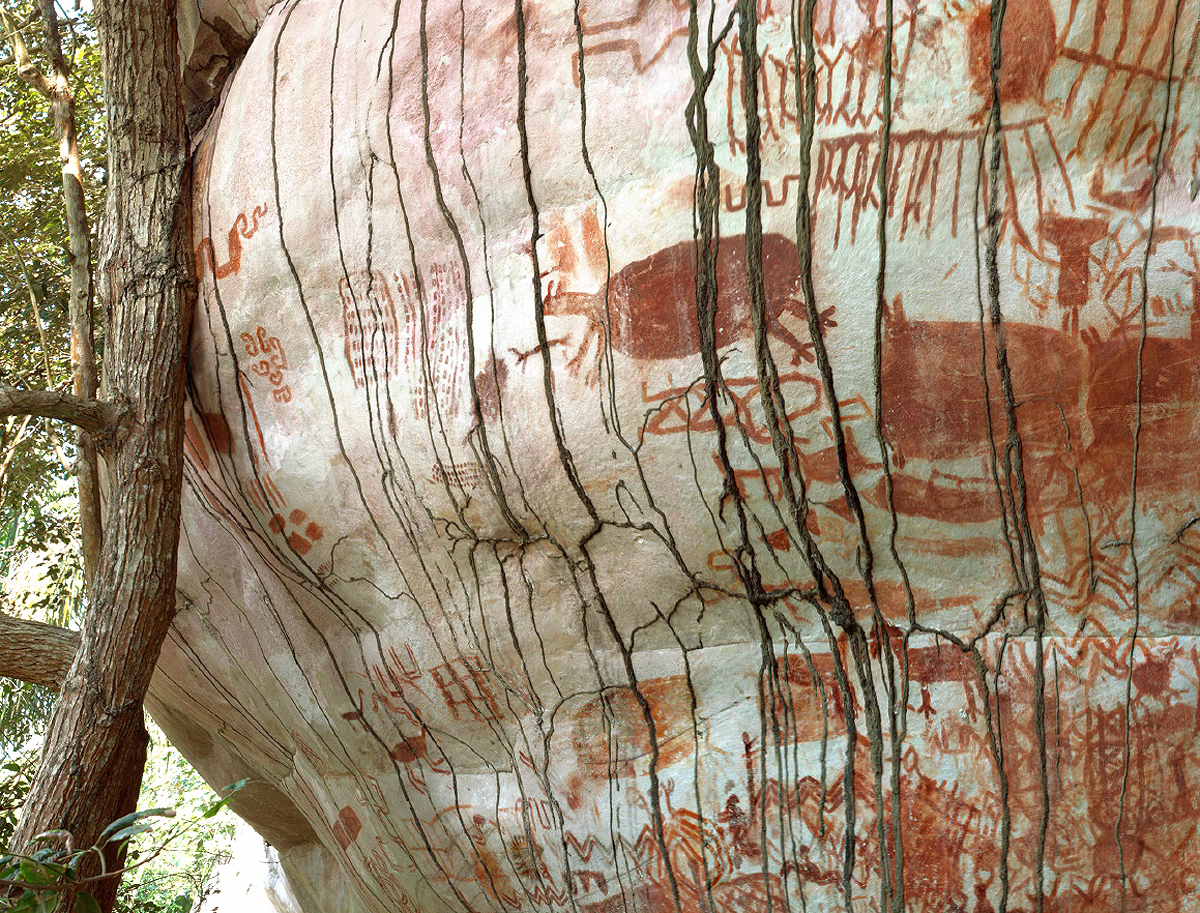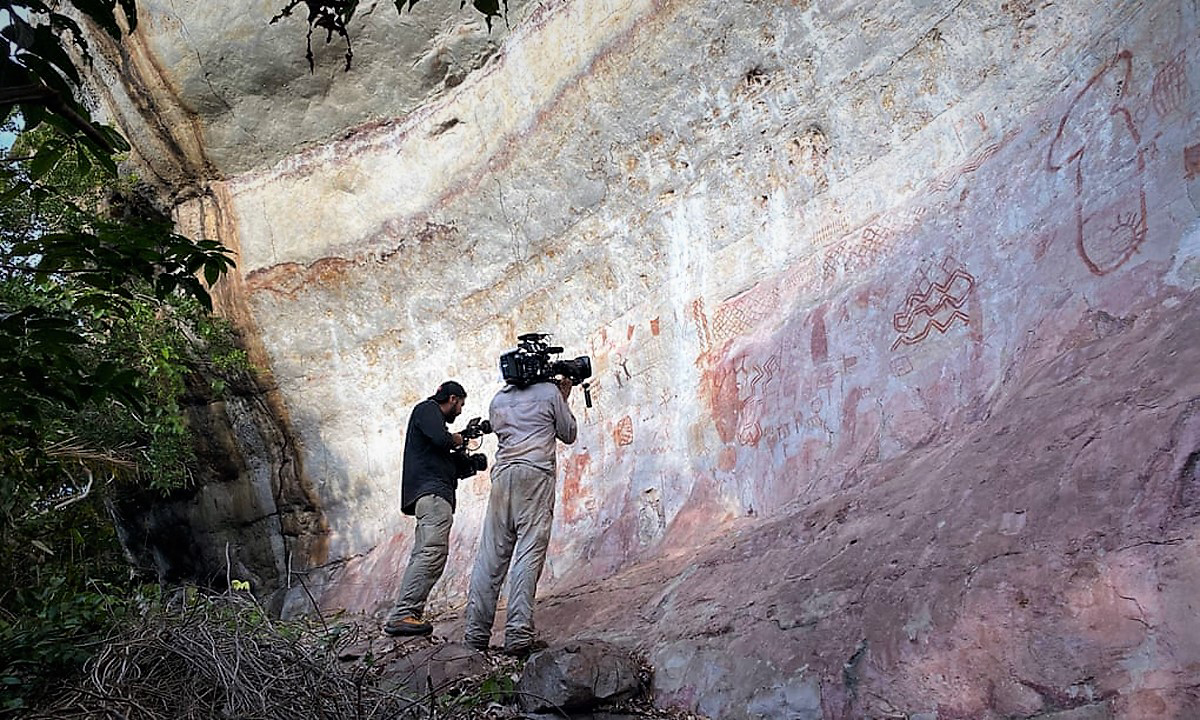


An article by Dalya Alberge on theguardian.com - 'Sistine Chapel of the ancients' rock art discovered in remote Amazon forest - reports on one of the world’s largest collections of prehistoric rock art which has been discovered in the Amazon rainforest.

Hailed as “the Sistine Chapel of the ancients”, archaeologists have found tens of thousands of paintings of animals and humans created up to 12,500 years ago across cliff faces that stretch across nearly eight miles in Colombia.
Promotional trailer of the research project of the rock art of Guaviare Colombia: archeometry, documentation and diagnosis of conservation of the rock paintings of the Serranía de la Lindosa and the Raudal de Guayabero. Made by GIPRI Colombia GEGEMA and sponsored by the National Archaeological Research Foundation (FIAN). Courtesy of Antonio Batarda Fernandes.
Their date is based partly on their depictions of now-extinct ice age animals, such as the mastodon, a prehistoric relative of the elephant that hasn’t roamed South America for at least 12,000 years. There are also images of the palaeolama, an extinct camelid, as well as giant sloths and ice age horses. These animals were all seen and painted by some of the very first humans ever to reach the Amazon. Their pictures give a glimpse into a lost, ancient civilisation. Such is the sheer scale of paintings that they will take generations to study.

The discovery was made last year, but has been kept secret until now as it was filmed for a major Channel 4 series to be screened in December: Jungle Mystery: Lost Kingdoms of the Amazon. The site is in the Serranía de la Lindosa where, along with the Chiribiquete national park, other rock art had been found. The documentary’s presenter, Ella Al-Shamahi, an archaeologist and explorer, told the Observer: “The new site is so new, they haven’t even given it a name yet.” She spoke of the excitement of seeing “breathtaking” images that were created thousands of years ago.
The discovery was made by a British-Colombian team, funded by the European Research Council. Its leader is José Iriarte, professor of archaeology at Exeter University and a leading expert on the Amazon and pre-Columbian history: “When you’re there, your emotions flow. We’re talking about several tens of thousands of paintings. It’s going to take generations to record them. Every turn you do, it’s a new wall of paintings. We started seeing animals that are now extinct. The pictures are so natural and so well made that we have few doubts that you’re looking at a horse, for example. The ice-age horse had a wild, heavy face. It’s so detailed, we can even see the horse hair. It’s fascinating.”

The images include fish, turtles, lizards and birds, as well as people dancing and holding hands, among other scenes. One figure wears a mask resembling a bird with a beak. The site is so remote that, after a two-hour drive from San José del Guaviare, a team of archaeologists and film-makers trekked on foot for around four hours.

The paintings vary in size. There are numerous handprints and many of the images are on that scale, be they geometric shapes, animals or humans. Others are much larger. Speculating on whether the paintings had a sacred or other purpose, Iriarte explains “It’s interesting to see that many of these large animals appear surrounded by small men with their arms raised, almost worshipping these animals.”
Observing that the imagery includes trees and hallucinogenic plants, he added: “For Amazonian people, non-humans like animals and plants have souls, and they communicate and engage with people in cooperative or hostile ways through the rituals and shamanic practices that we see depicted in the rock art.”
Jungle Mystery: Lost Kingdoms of the Amazon starts at 6.30pm on Channel 4 on 5 December. The rock art discovery is in episode 2, on 12 December.
by Bradshaw Foundation
Wednesday 23 July 2025
by Bradshaw Foundation
Thursday 29 May 2025
by Bradshaw Foundation
Monday 03 February 2025
by Bradshaw Foundation
Friday 09 August 2024
by Bradshaw Foundation
Wednesday 24 July 2024
by Bradshaw Foundation
Thursday 04 July 2024
by Bradshaw Foundation
Monday 01 July 2024
by Bradshaw Foundation
Wednesday 20 March 2024
by Bradshaw Foundation
Tuesday 13 February 2024
by Bradshaw Foundation
Tuesday 13 February 2024
by Bradshaw Foundation
Thursday 01 February 2024
by Bradshaw Foundation
Tuesday 28 November 2023
by Bradshaw Foundation
Thursday 23 November 2023
by Bradshaw Foundation
Monday 20 November 2023
by Bradshaw Foundation
Tuesday 31 October 2023
by Bradshaw Foundation
Thursday 26 October 2023
by Bradshaw Foundation
Wednesday 23 July 2025
by Bradshaw Foundation
Thursday 29 May 2025
by Bradshaw Foundation
Monday 03 February 2025
by Bradshaw Foundation
Friday 09 August 2024
by Bradshaw Foundation
Wednesday 24 July 2024
by Bradshaw Foundation
Thursday 04 July 2024
by Bradshaw Foundation
Monday 01 July 2024
by Bradshaw Foundation
Wednesday 20 March 2024
by Bradshaw Foundation
Tuesday 13 February 2024
by Bradshaw Foundation
Tuesday 13 February 2024
by Bradshaw Foundation
Thursday 01 February 2024
by Bradshaw Foundation
Tuesday 28 November 2023
by Bradshaw Foundation
Thursday 23 November 2023
by Bradshaw Foundation
Monday 20 November 2023
by Bradshaw Foundation
Tuesday 31 October 2023
by Bradshaw Foundation
Thursday 26 October 2023
Friend of the Foundation











